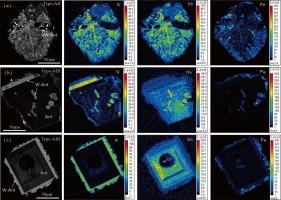Microstructures and element geochemistry of anatase from the Laozuoshan gold skarn deposit, NE China
IF 3.6
2区 地球科学
Q1 GEOLOGY
引用次数: 0
Abstract
Rutile, anatase, and brookite are polymorphs of titanium dioxide (TiO2), and occur as accessory minerals in various lithologies. They provide important information for revealing magmatic–hydrothermal ore formation, yet the mineralogical characteristics and genesis of hydrothermal anatase is not well established. In this study, we focus on the texture and geochemical composition of anatase from the auriferous ore (quartz–ankerite–pyrrhotite–arsenopyrite vein) and barren rock (quartz–ankerite vein) from the Laozuoshan deposit. Five types of anatase were discovered, including (1) type-AI and −BI anatase in auriferous ore and barren rock, characterized by being homogeneous and isolated without mineral inclusions; (2) type-AII and −BII anatase in auriferous ore and barren rock, usually contains some biotite, ankerite, zircon or apatite inclusions. Some type-AII anatase grains in the auriferous ore show patchy zoning; (3) type-AIII anatase (only in auriferous ore) is characterized by well-developed sector or normal zoning. High W content is distributed in the patches and sector zones of type-AII and −AIII anatase, which could be attributed to the W substitution for Ti in the anatase. We suggest that F-rich ore fluids could facilitate the W incorporation into the anatase crystal, and W-rich anatase can serve as an indicator mineral for gold skarn exploration.

老左山金夕卡岩中锐钛矿的显微结构及元素地球化学
金红石、锐钛矿和brookite是二氧化钛(TiO2)的多晶型矿物,作为辅助矿物存在于各种岩性中。它们为揭示岩浆-热液成矿提供了重要信息,但热液锐钛矿的矿物学特征和成因尚不清楚。本文重点研究了老左山金矿床含金矿石(石英—针铁矿—磁黄铁矿—毒砂脉)和贫岩(石英—针铁矿脉)中锐钛矿的结构和地球化学组成。在含金矿石和贫岩中发现了5种类型的锐钛矿,包括(1)- ai型和- BI型锐钛矿,其特征为均质、孤立,无矿物包裹体;(2) - aii型和- BII型锐钛矿在含金矿石和贫岩中,通常含有一些黑云母、铁云母、锆石或磷灰石包裹体。含金矿石中部分ⅰ型锐钛矿颗粒呈斑片状分带;(3) aiii型锐钛矿(仅在含金矿石中)扇形发育或分带正常。在- aii型和- AIII型锐钛矿斑块区和扇形区均有较高的W含量,这可能与锐钛矿中W取代Ti有关。富f矿液有利于W向锐钛矿晶体的掺入,富W锐钛矿可作为金夕卡岩找矿的指示矿物。
本文章由计算机程序翻译,如有差异,请以英文原文为准。
求助全文
约1分钟内获得全文
求助全文
来源期刊

Ore Geology Reviews
地学-地质学
CiteScore
6.50
自引率
27.30%
发文量
546
审稿时长
22.9 weeks
期刊介绍:
Ore Geology Reviews aims to familiarize all earth scientists with recent advances in a number of interconnected disciplines related to the study of, and search for, ore deposits. The reviews range from brief to longer contributions, but the journal preferentially publishes manuscripts that fill the niche between the commonly shorter journal articles and the comprehensive book coverages, and thus has a special appeal to many authors and readers.
 求助内容:
求助内容: 应助结果提醒方式:
应助结果提醒方式:


